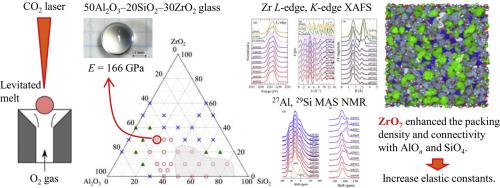当前位置:
X-MOL 学术
›
Acta Mater.
›
论文详情
Our official English website, www.x-mol.net, welcomes your
feedback! (Note: you will need to create a separate account there.)
Densely packed glass structure caused by seven-coordinated Zr in high elastic modulus Al2O3–SiO2–ZrO2 glasses
Acta Materialia ( IF 8.3 ) Pub Date : 2024-11-06 , DOI: 10.1016/j.actamat.2024.120549 Atsunobu Masuno, Yuki Mikami, Yutaka Yanaba, Yuji Higo, Shunta Sasaki, Io Sato, Toyonari Yaji, Gustavo A. Rosales-Sosa, Hiroyuki Inoue
Acta Materialia ( IF 8.3 ) Pub Date : 2024-11-06 , DOI: 10.1016/j.actamat.2024.120549 Atsunobu Masuno, Yuki Mikami, Yutaka Yanaba, Yuji Higo, Shunta Sasaki, Io Sato, Toyonari Yaji, Gustavo A. Rosales-Sosa, Hiroyuki Inoue

|
Al2 O3 –SiO2 –ZrO2 ternary glasses were fabricated using a levitation technique. The addition of ZrO2 to the Al2 O3 –SiO2 glasses strongly affected their thermal, mechanical, and structural properties. Several compositions were partially vitrified at the laser-melted area without levitation although their melting required temperatures higher than 2000 °C. With increasing ZrO2 content, the elastic moduli linearly increased, and the 50Al2 O3 –20SiO2 –30ZrO2 glass exhibited a Young′s modulus of 166 GPa and Vickers hardness H V of 10.6 GPa. Conversely, crack resistance significantly decreased with the addition of ZrO2 . Density measurements, Zr L 2,3 -edge and K -edge X-ray absorption fine structure analyses, and 27 Al and 29 Si magic-angle spinning nuclear magnetic resonance spectroscopy were performed to investigate the local structure around Zr, Al, and Si in the glasses. Zr formed distorted ZrO7 as in monoclinic ZrO2 , which has been rarely found in conventional oxide glasses. The highly oxygen-coordinated Al atoms such as AlO5 and AlO6 , were the main components in the glasses rather than AlO4 . The majority of Si atoms form SiO4 with four bridging oxygen (Q4 ). Among the four bridging oxygens, the number of oxygens connected to Al or Zr clearly increased with decreasing SiO2 content. The high packing density of the ternary glasses that resulted in high elastic moduli originated from the highly oxygen-coordinated Zr and Al and their close bonding with SiO4 without generating nonbridging oxygens.
中文翻译:

高弹性模量 Al2O3–SiO2–ZrO2 玻璃中由七个配位 Zr 引起的致密堆积玻璃结构
Al2O3–SiO2–ZrO2 三元玻璃采用悬浮技术制造。在 Al2O3-SiO2 玻璃中添加 ZrO2 强烈影响了它们的热、机械和结构性能。几种组合物在激光熔化区域部分玻璃化而没有悬浮,尽管它们的熔化需要高于 2000 °C 的温度。 随着 ZrO2 含量的增加,弹性模量线性增加,50Al2O3–20SiO2–30ZrO2 玻璃的杨氏模量为 166 GPa,维氏硬度 HV 为 10.6 GPa。相反,随着 ZrO2 的加入,抗裂性显着降低。进行了密度测量、Zr L2,3 边缘和 K 边缘 X 射线吸收精细结构分析,以及 27Al 和 29Si 魔角旋转核磁共振波谱,以研究玻璃中 Zr、Al 和 Si 周围的局部结构。Zr 形成扭曲的 ZrO7 就像在单斜晶系 ZrO2 中一样,这在传统的氧化物玻璃中很少见。高度氧配位的 Al 原子,如 AlO5 和 AlO6,是玻璃中的主要成分,而不是 AlO4。大多数 Si 原子形成 SiO4 与四个桥接氧 (Q4)。在四种桥接氧中,随着 SiO2 含量的降低,与 Al 或 Zr 相连的氧的数量明显增加。三元玻璃的高堆积密度导致高弹性模量,这源于高度氧配位的 Zr 和 Al 以及它们与 SiO4 的紧密结合,而不会产生非桥接氧。
更新日期:2024-11-06
中文翻译:

高弹性模量 Al2O3–SiO2–ZrO2 玻璃中由七个配位 Zr 引起的致密堆积玻璃结构
Al2O3–SiO2–ZrO2 三元玻璃采用悬浮技术制造。在 Al2O3-SiO2 玻璃中添加 ZrO2 强烈影响了它们的热、机械和结构性能。几种组合物在激光熔化区域部分玻璃化而没有悬浮,尽管它们的熔化需要高于 2000 °C 的温度。 随着 ZrO2 含量的增加,弹性模量线性增加,50Al2O3–20SiO2–30ZrO2 玻璃的杨氏模量为 166 GPa,维氏硬度 HV 为 10.6 GPa。相反,随着 ZrO2 的加入,抗裂性显着降低。进行了密度测量、Zr L2,3 边缘和 K 边缘 X 射线吸收精细结构分析,以及 27Al 和 29Si 魔角旋转核磁共振波谱,以研究玻璃中 Zr、Al 和 Si 周围的局部结构。Zr 形成扭曲的 ZrO7 就像在单斜晶系 ZrO2 中一样,这在传统的氧化物玻璃中很少见。高度氧配位的 Al 原子,如 AlO5 和 AlO6,是玻璃中的主要成分,而不是 AlO4。大多数 Si 原子形成 SiO4 与四个桥接氧 (Q4)。在四种桥接氧中,随着 SiO2 含量的降低,与 Al 或 Zr 相连的氧的数量明显增加。三元玻璃的高堆积密度导致高弹性模量,这源于高度氧配位的 Zr 和 Al 以及它们与 SiO4 的紧密结合,而不会产生非桥接氧。


















































 京公网安备 11010802027423号
京公网安备 11010802027423号